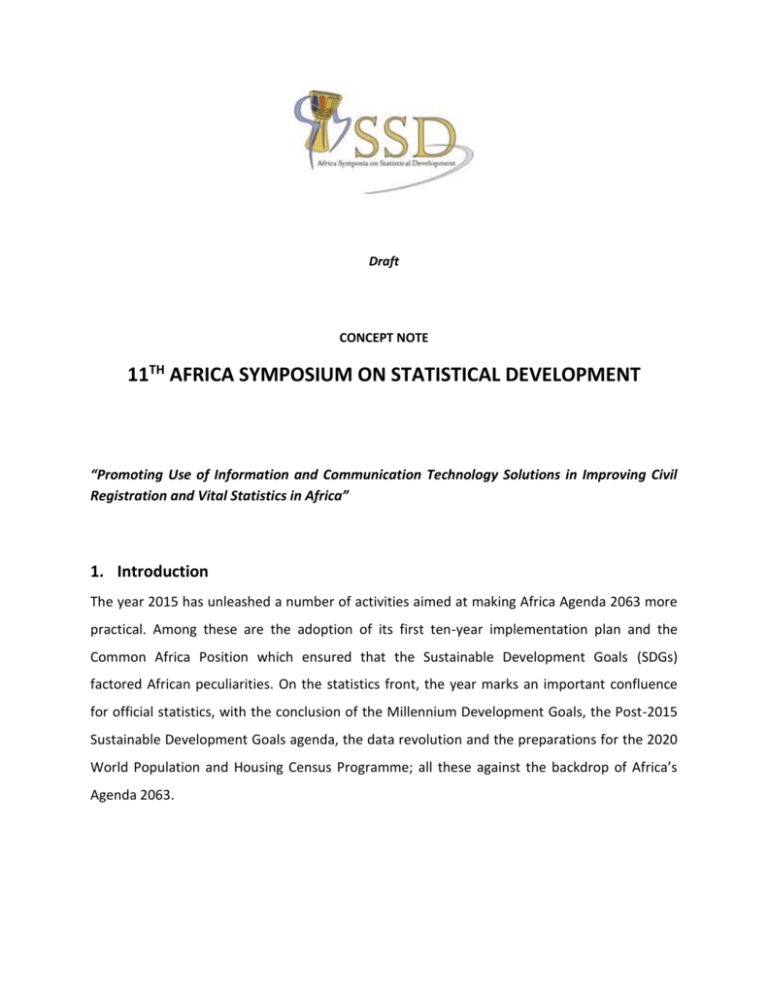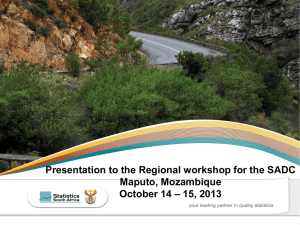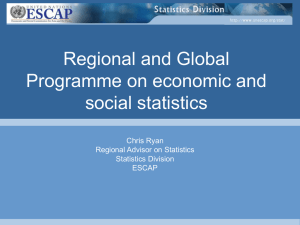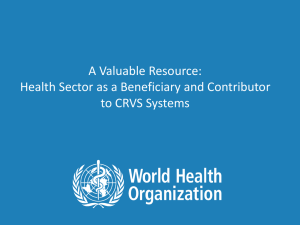here - Statistics South Africa
advertisement

Draft CONCEPT NOTE 11TH AFRICA SYMPOSIUM ON STATISTICAL DEVELOPMENT “Promoting Use of Information and Communication Technology Solutions in Improving Civil Registration and Vital Statistics in Africa” 1. Introduction The year 2015 has unleashed a number of activities aimed at making Africa Agenda 2063 more practical. Among these are the adoption of its first ten-year implementation plan and the Common Africa Position which ensured that the Sustainable Development Goals (SDGs) factored African peculiarities. On the statistics front, the year marks an important confluence for official statistics, with the conclusion of the Millennium Development Goals, the Post-2015 Sustainable Development Goals agenda, the data revolution and the preparations for the 2020 World Population and Housing Census Programme; all these against the backdrop of Africa’s Agenda 2063. Agenda 2063 is the African Union’s vision of “An Integrated, prosperous and peaceful Africa, driven by its own citizens and representing a dynamic force in the global arena” and hinges on seven critical pillars: (i) a prosperous Africa based on inclusive growth and sustainable development; (ii) an integrated continent, politically united, based on the ideals of Pan Africanism; (iii) an Africa of good governance, democracy, respect for Human Rights, Justice and the Rule of Law; (iv) a peaceful and secure Africa; (v) an Africa with strong cultural values and ethics; (vi) an Africa where development is people-driven, relying particularly on the potential of women and youth; and (vii) Africa as a strong and influential global player and partner. The UN High-Level Panel on the Post-2015 Development Agenda recommended that the new development agenda be guided by the vision of eradicating extreme poverty once and for all in the context of sustainable development. While envisioning the post-2015 development agenda as a universal vision, the panel proposed that it should be driven by five big, transformative shifts1. Among them, the first ‘leave no one behind’ underscores the need to ensure that no person – regardless of ethnicity, gender, geography, disability, race or other status – is denied universal human rights and basic economic opportunities. The Panel has also put emphasis on the need for monitoring development-related indicators at disaggregated levels. It also called for a data revolution for sustainable development, with a new international initiative to improve the quality of statistics and information available to citizens. The African Symposium on Statistical Development led by Statistics South Africa as its Secretariat will be holding its 11th event on 23–25 November 2015. Since its advent in 2006, it has brought the statistical community in Africa together annually to tackle strategic challenges confronting the African Statistics System. It is a forum that came about when African statisticians gathered in Yaoundé, Cameroon in the year 2005. Taking place against a background of poor performance of African countries in undertaking population census previously and a report that painted an unimpressive picture of the continent’s state of readiness for the 2010 Round of Population and Housing Censuses, it was decided that 1 The five big transformative shifts proposed are: 1. Leave no one behind; 2. Put sustainable development at the core; 3. Transform economies for jobs and inclusive growth; 4. Build peace and effective, open and accountable institutions for all; and 5. Forge a new global partnership. something needed to be done to improve the situation going forward. A fortification meeting was subsequently held in Cape Town in 2006 which ushered in the ASSD as a standing platform with an initial objective of mobilising all African countries to ensure that they carried out censuses in the 2010 round covering the period 2005–2014. The Yaoundé meeting was held in the wake of a report by the United Nations SecretaryGeneral, Kofi Annan to the General Assembly in September 2005 that showed glaring data gaps in monitoring progress made in Africa on the Millennium Development Goals (MDGs). The main resolution of the first ASSD meeting in Cape Town was the call to Africa’s National Statistics Offices to re-enforce the need for the African statistical community to meet on an annual basis to engage actively in the ongoing revision of the Principles and Recommendations on Population and Housing Censuses (PHCs) to share best practices in the planning and management, execution, processing, analysis and dissemination of census data. Amplifying and complementing this resolution was the decision of the 39th Session of the United Nations Economic Commission for Africa (ECA) Conference of Ministers of Finance, Planning and Economic Development held in Ouagadougou in May 2006 that assistance should be provided to countries emerging out of conflict. Furthermore, governments were called upon to make resources available for successful census taking. In carrying out these resolutions, the ASSD became an important platform for the African statistical community in its desire to realise unprecedented statistical development efforts on the continent. Five ASSDs were subsequently held in Kigali (Rwanda), Accra (Ghana), Luanda (Angola), Dakar (Senegal) and Cairo (Egypt). The Ministers responsible for CRVS in Africa in their first conference held in Addis Ababa, Ethiopia in August 2010 implored African statisticians to address yet another problem bedeviling the continent: CRVS. The Heads of National Statistics Offices adopted a resolution at the 6 th ASSD held in Cairo, Egypt to implement the CRVS Ministers Call. The 7th, 8th, 9th and 10th editions of the ASSD held in Cape Town (South Africa), Yamoussoukro (Cote d’Ivoire), Gaborone (Botswana), and Kampala (Uganda) respectively, dealt with CRVS. 2. The 11th ASSD The 11th ASSD’s significance is threefold: firstly, it marks the end of the Civil Registration and Vital Statistics round of symposia and the unveiling of a new focus; secondly, it is an entry point into the second cluster of ten symposia; and finally, it will be the first to be held back-to-back with the Statistics Commission for Africa and the Committee of Directors-General of National Statistics Offices. It will be held under the theme: “Promoting Use of Information and Communication Technology Solutions in Improving Civil Registration and Vital Statistics in Africa”. The overall objective of the 11th ASSD is to rally member States around a united statistical programme aimed at supporting the implementation, monitoring and evaluation of Africa Agenda 2063 vision. There are four topics to be covered in the 11th ASSD. The first three, namely the use of ICT, the Africa mortality strategy and monitoring of implementation of APAI-CRVS are civil registration-oriented whilst the fourth focuses on population and housing censuses. 2.1 Use of ICT in CRVS Recent comprehensive assessments have revealed that the Information and Communication Technology (ICT) used for Civil Registration and Vital Statistics (CRVS) across Africa is at varying levels of maturity and effectiveness, ranging from very advanced automated systems to basic off-line data entry systems. ICT has the potential to provide transformative improvements in CRVS due to its ability, among others, to improve access to services, increase coverage, standardise and streamline registration processes, allow system interoperability and provide large-scale and secure data storage, all in a cost-effective way. In reality, however, ICT solutions are often not fully suited to the country context and hence are not able to fully support the holistic aspects of CRVS in a sustainable way. To address this situation, the African Programme for the Accelerated Improvement of CRVS (APAI-CRVS) has recognised the need for comprehensive guidelines to support countries intending to digitise their CRVS processes and to maximise the impact of ICT investments. The Guidebook on CRVS Digitisation was commissioned by the African Development Bank and UN Economic Commission for Africa (ECA) and was developed by Plan International and Jembi Health Systems on behalf of the APAI-CRVS. It is an online resource that provides step-by-step guidance for countries to plan, analyse, design and implement digitised systems and automated processes for CRVS, in particular within low resource settings. Consistent with the APAI-CRVS strategic direction, the primary target audience of the Guidebook will be the civil registration authorities and national statistical offices responsible for CRVS services in-country. The Guidebook will be launched during the 11th ASSD and responds to the APAI-CRVS objective to provide management and programmatic guidance to the regional agenda of reforming and improving CRVS systems2. 2.2 Africa Mortality Strategy (2015–2020) Countries, and regional and global development partners, recognise that mortality statistics improvement in Africa is critical to future health development. The Sustainable Development Goals (SDGs) focus attention on the need for broad-based mortality data. The recent Ebola outbreak demonstrates the need for real-time mortality data to be in place in all countries. Maternal and child health, as well as HIV/AIDS, malaria and TB remain critical global health concerns. Since December 2013, partners including WHO, UNECA and ASSD have been considering better ways to promote integrated mortality statistics development under the APAI-CRVS strategy. In February 2015, the African Ministers responsible for Civil Registration, including many African 2 As per the Medium Term Plan (MTP) endorsed by the First Conference of African Ministers responsible for Civil Registration in Addis Ababa, 2010. Ministers of Health, made a declaration (‘Yamoussoukro Declarations’) recognising the critical need for real-time mortality data in African countries, especially in the aftermath of the Ebola outbreak. The declaration specifically called on WHO in conjunction with its Pan African partners to intensify this effort in developing mortality data at country level. Health Ministers in Africa, including those in the WHO EMRO region, have specifically committed to improvement of CRVS systems, and mortality data, as a priority: The Africa CRVS Core Group agreed to develop a Five-year Regional Strategy for Improving Mortality STATISTICS in Africa; supported by an African partnership focused on improving mortality data. This consequent strategy and its implementation is the result of a collaboration between WHO, UNECA, the ASSD secretariat, and their many regional and global partners committed to ensuring that for the future, Africa has a better ability to generate and use its own mortality data for its own health needs, recognising also that this statistical development generates strong benefits for Africa’s CRVS systems. A regional reference group3 was formed in August 2015 to consider how best to progress mortality statistics as an agenda within the APAI-CRVS. The group identified that the challenges are many: Fragmented systems which have developed over time mean that countries have multiple systems to join together in some type of coherent statistical framework. Development options have never previously sought to build regional expertise to the extent that this plan intends. Regional institutions were not built or sustained to provide support for the African region. However, the group also agreed that the opportunities are plentiful. Countries have committed politically and technically to improving their mortality statistics. The opportunity for new 3 Led by ASSD, WHO and UNECA, and comprising representatives from the African Union, Africa Development Bank, UNFPA, World Bank, Global Fund, INDEPTH network, Paris 21, and Bloomberg Philanthropies. thinking in this area – methodological, analytical, and developmental – is exciting. Africa houses significant and varied technical expertise, along with extensive practical implementation experiences. It hosts strong technical institutions and partnerships, backed politically, through the APAI-CRVS. The five-year mortality statistics developed by the reference group will be presented at the ASSD for endorsement by the countries. The vision of the strategy is to record all deaths in Africa and their corresponding causes, to provide essential information to shape resilient health systems for healthy African lives. The mission is for African countries to record continuous data on all deaths, including causes of death, and improve mortality statistics, through better planned, designed and integrated mortality systems. This strategy seeks to build four key building blocks necessary for sustained mortality statistics: development of country and regional expertise, able to be deployed to suit African technical needs; scaled and integrated technical projects built for the benefit of African countries, and housed regionally; norms, standards, guidance relevant to contemporary African country needs; and knowledge development and sharing, including south-south learning. 2.3 Monitoring the implementation of APAI-CRVS The Ministers responsible for civil registration in their second conference held in Durban in 2012 had resolved to develop results-based monitoring and evaluation systems and tools to monitor and report on progress on CRVS. The monitoring framework should encompass: a) monitoring of the implementation of the activities of the CRVS programme; and b) monitoring of completeness of registration of vital events. The monitoring as stated in a) above has to happen at both the country and regional level. At the country level it would essentially mean monitoring of activities of the plan developed by the countries based on the comprehensive assessment. Some countries may already have developed monitoring mechanisms to track the progress of implementation of the plan. At the regional level the regional core group has developed a monitoring format for the countries to report on an annual basis. This format, which is on-line, can be filled in by the CRVS focal points in the countries and submitted by the end of March for the preceding calendar year. The format will be presented by the secretariat in the workshop. Some of the countries will also present their own CRVS monitoring mechanisms. Measurement of completeness of vital events has been one the major challenges that the APAICRVS has been grappling with in the last five years. Most African countries do not have systems that regularly measure the completeness level of registration of even births and deaths. The levels of birth registration are mostly available from surveys, such as the Multi-Indicator Cluster Survey (MICS), which are far and few between. Measurement of death registration levels is not available from any such surveys. The lack of such basic information on levels of registration on a regular basis makes it impossible for the CR managers in countries to monitor the performance of civil registration completeness at different levels and make necessary corrective and timely interventions. This also seriously hinders reporting progress of registration to the ministers in real quantitative terms. Keeping this in view, the APAI-CRVS Secretariat will present a methodology for direct measurement of completeness of registration of vital events in countries. The process for continuously monitoring the number of events registration that needs to be integrated as a part of the routine process of registration will also be discussed. 2.4 2020 Round of Population and Housing Censuses (PHC) The 2020 Round of PHC has started and a number of countries have already started preparing and planning for the censuses. The unprecedented feat achieved in the 2010 Round in terms of the number of countries that conducted a census should be repeated in the current round. The ASSD, as in the previous census round, should continue to play a pivotal role in advocating with countries on the continent to not only undertake a census, but also do so in the time period it is planned for. The ECA in collaboration with the AfDB had conducted an assessment of the 2010 Round of PHC in Africa and presented a report at the Third Session of StatCom Africa held in Tunis, Tunisia in December 2014. A number of recommendations have been made in the report that need to be considered and acted upon. The StatCom also approved the establishment of a Regional Task Force with all relevant stakeholders to provide technical support and guidance to member states, keeping in view the international principles and guidelines on the subject and the special requirements of the continent. The Task Force will develop a five-year programme for this purpose. The Task Force was also supposed to submit and develop a five-year programme for this purpose. The 10th ASSD also made similar recommendations on the 2020 Round of PHC including development of an African Addendum to the 3 rd Revision of the International Principles and Recommendations on PHC. The ECA and AfDB will present a draft five-year programme at the ASSD for discussion, which later will be submitted to the Fifth Session of the StatCom. The ASSD will also propose the composition of a Regional Task Force on PHC which can later be endorsed by the StatCom. 2.5 Expected accomplishments The 11th Symposium is expected to deliver the following: A continental progress report on the APAI-CRVS programme with lessons learnt and way forward. A Programme of Action for the 2020 Round of Population and Housing Censuses embedding lessons learnt from the 2010 round. 11th ASSD recommendations and resolutions. 2.6 Activities The activities to be undertaken in organising the 11th ASSD will include the following specific pre-symposium activities: Preparatory meetings of the ASSD International Planning Committee, the National Organising Committee and work streams; Preparing concept note and work programme; Undertaking advocacy and resource mobilisation activities; Invitation and arrangement of logistics; and Identification and communication of resource persons. Activities during the symposium will cover the actual implementation of the work programme of the meeting. On the other hand, post-meeting activities will include handling of administrative and logistics issues and preparation of reports and related activities. Accordingly, the organisers are expected to handle financial and logistics issues and prepare and disseminate the meeting reports. 2.7 Organisers of the Symposium The 11th ASSD will be hosted by the Republic of Gabon which has constituted a National ASSD Committee (NASSDC) headed by the Director-General of the Directorate-General of Statistics, and drawing membership from all government ministries and key development partners. The NASSDC is supported by an International Planning Committee which includes Statistics South Africa as the ASSD Secretariat, the ECA as the CRVS Secretariat, the AfDB, AUC, UNFPA, UNICEF, WHO and other partners. 2.8 Participants The 11th Symposium is expected to bring a total of about 400 delegates made up of participants from NSOs and Civil Registration Authorities in Africa, representatives of regional and international organisations, as well as invited participants from different institutions and associations. 2.9 Venue and Date The meeting will be held at the d’Agondje Friendship Soccer Stadium in Akanda (Libreville) from 23 to 25 November 2015.









